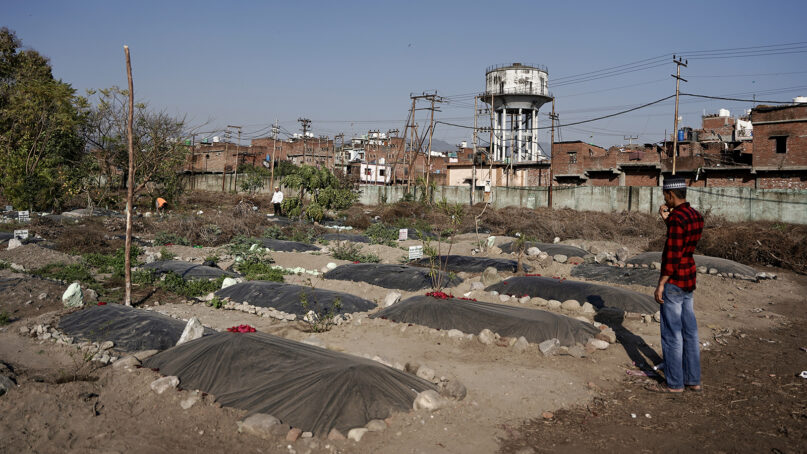HALDWANI, India (RNS) — Despite fears of a police crackdown, hundreds of Muslim men had come out on Feb. 15 for “Shab-e-Baraat,” the night of forgiveness, gathering in a vast, wooded graveyard in this city near the Nepal border to pray for the souls of their departed.
Among the graves are six fresh mounds in a line, covered with fresh rose petals and black tarpaulin, the burial sites of men cut down a week earlier, when the police fired on Muslims protesting the demolition of a mosque and its madrassa, or religious school. The buildings, the authorities said, illegally occupied government-owned land.
Mohammad Zahid, 45, had left home not to demonstrate but to fetch milk for a relative’s baby. His son, 21-year-old Mohammad Aman, said his family had gotten a call saying, “Your father has been shot. Come quickly,” but when Aman and others arrived and put his father on a wooden cart, “the policemen caught us, started beating me, calling (me) names like ‘terrorist,’ ‘Falestini’ (Palestinian),” said Aman. “They also hit my father, who was still breathing.”
At a makeshift medical office down the narrow lanes of the Muslim ghetto of Banbhoolpura, another patient was already being treated for a gunshot wound. “I saw the face and it was my younger brother, Anas,” he said. “I could not understand anything and I fell down, shocked.” Both died of their wounds.
The next morning, officials allowed family members to bury the two bodies and complete Islamic rituals. “The policemen responsible for this should be tried by law. Can they kill anyone and it is fine?”
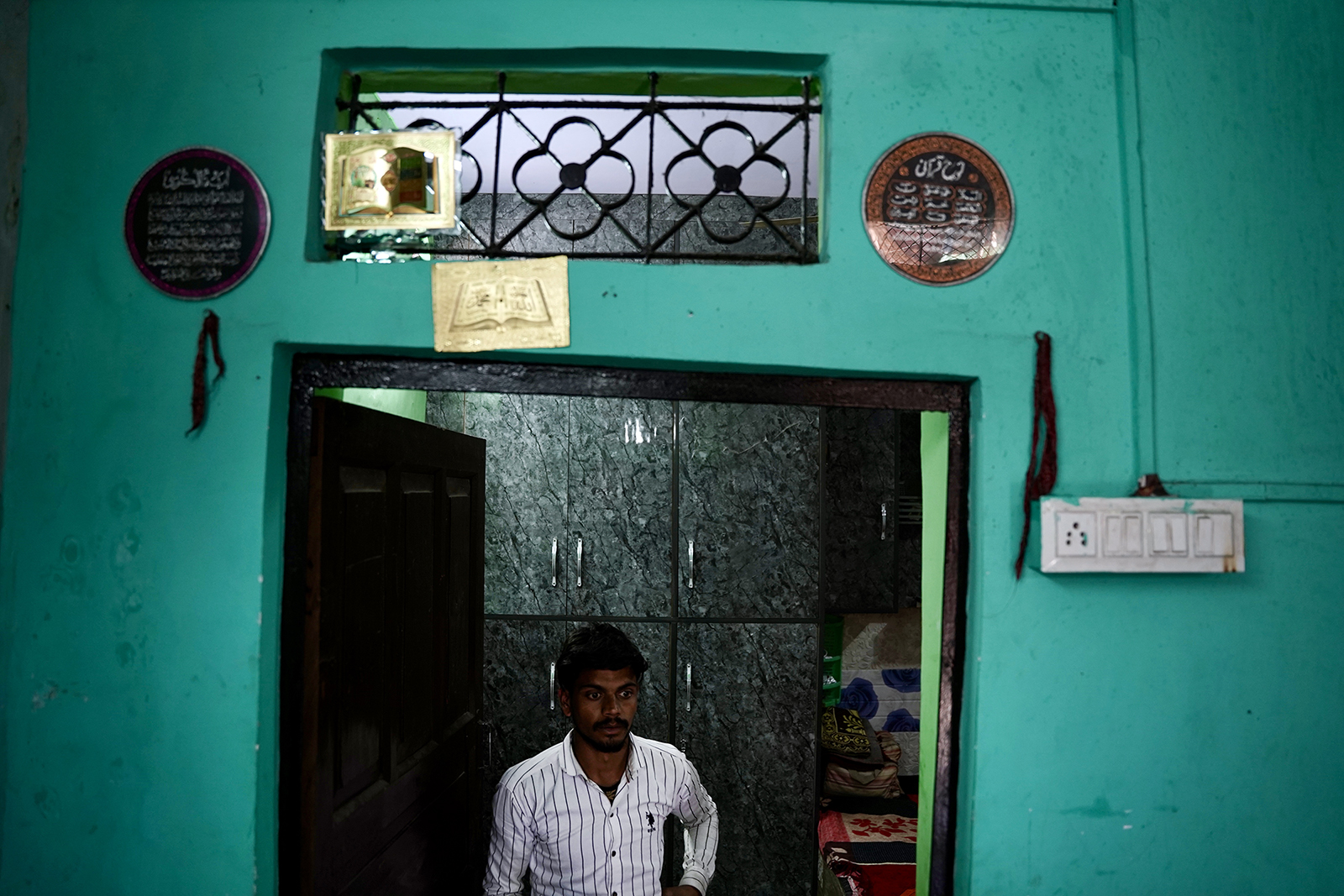
Mohammad Aman lost his father and brother following a police crackdown in Haldwani, India. (Photo by Bhat Burhan)
Uttrakhand, the relatively small Indian state where Haldwani is the financial capital, has been emerging as a hotbed of anti-Muslim violence. Its chief minister, Pushkar Singh Dhami, a hardline Hindu nationalist associated with Indian Prime Minister Narendra Modi’s Bharatiya Janata Party, has been positioning the state as a holy land for Hindus, with no place for religious minorities. Muslims make up about a third of the city’s 220,000 residents.
Since 2014, when Modi rose to power in India, Hindu nationalists have been increasingly targeting Muslims’ homes and places of worship. In 2022, a court in Uttarakhand ordered the destruction of thousands of houses, saying they encroached on a railway line. On Feb. 8, the mosque and school were razed, and a mob gathered at the local police station, leading to repeated clashes.
After police officers were injured, the local administration issued shoot-on-sight orders for anyone breaking curfew.
As Aman was mourning the loss of his father and younger brother, police, still riled up after clashes, returned to the neighborhood to damage vehicles and thrash anyone they found, local residents told Religion News Service.
The police have arrested nearly 80 people in the crackdown. After the violence, the district police chief, Prahlad Narayan Meena, told the reporters that the police were planning to lodge charges against 19 named and 5,000 unidentified people.
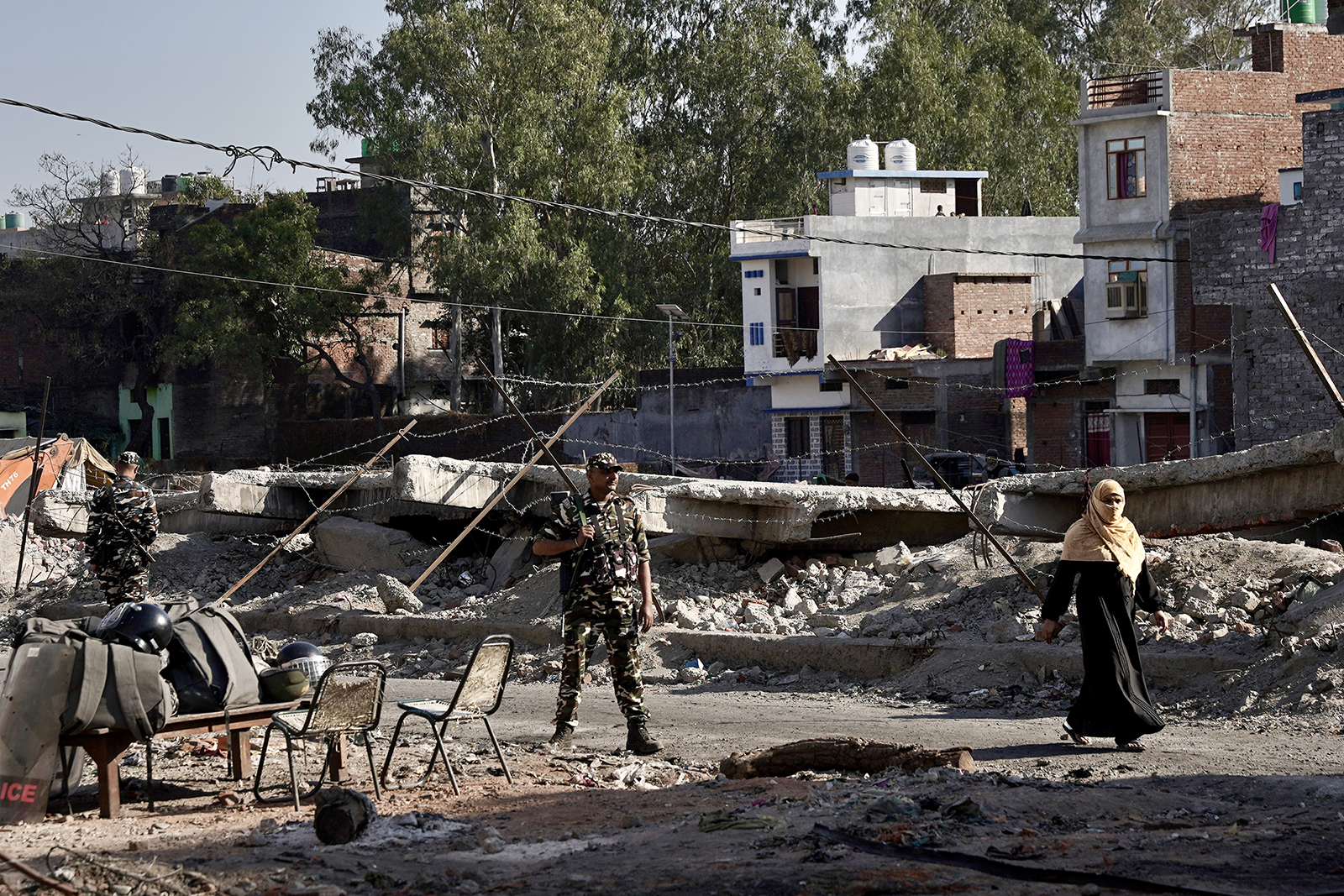
A pedestrian, right, passes the guarded site of a former mosque and its madrassa in Haldwani, India, Feb. 23, 2024. Unrest erupted following the destruction of the Muslim house of worship. (Photo by Bhat Burhan)
When the police came knocking down the doors, unlike the other boys from the neighborhood who ran away fearing torture, 17-year-old Mohammad Kaif’s mother rushed him upstairs, but the autistic teenager shouted at the sight of men in uniform and was beaten until he lost consciousness.
“They kept saying, ‘Ab maar patthar!’ (throw stones now),” the teen recalled, his arm still bandaged and face injured. “I was shivering and kept repeating that I did not do anything. No one heard me.”
By the time his mother rushed upstairs, he was lying in a pool of blood. “The police only left after I fell on the floor, scared that I died,” Kaif said.
Hearing the teen’s screams, Firdous Makrani, Kaif’s neighbor, told her husband, Abdul Sajid, to run. He was arrested at a police checkpoint. After two weeks, Sajid, 40, remains in jail. When Firdous went to meet him, she said, he only cried, hugging their two children. “He is worried how will I bring him out of jail?”
The Makrani family has not yet hired a lawyer, banking on negotiations by local clerics.
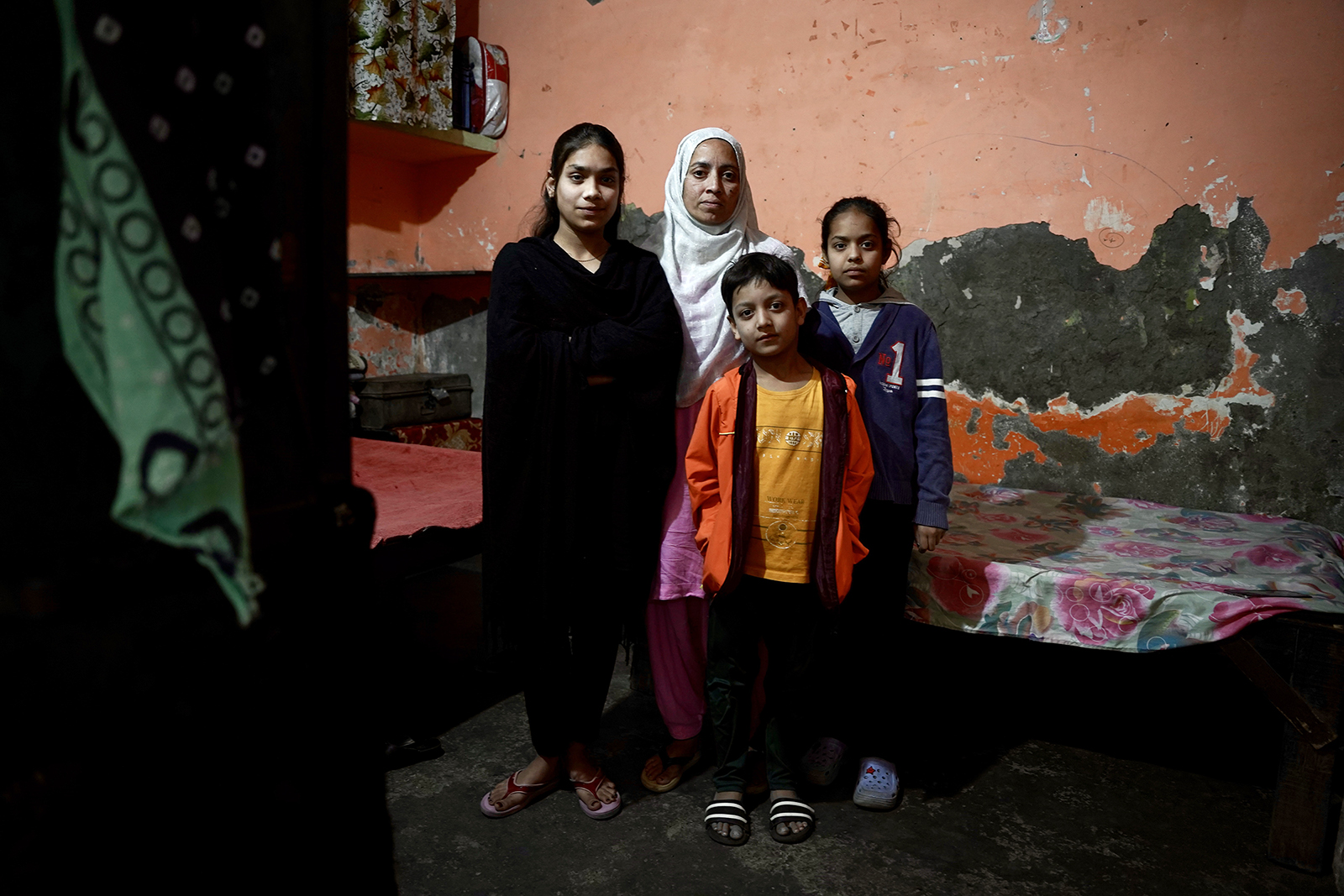
Firdous Makrani, center, and her family are hoping for the release of her husband, Abdul Sajid, in Haldwani, India. (Photo by Bhat Burhan)
A week after the rioting, men were lined up outside the mosques for afternoon prayers. Policemen and paramilitary were keeping a close eye. In a nearby neighborhood behind the now-demolished mosque, where doors have been smashed, people peeked from their windows into the narrow alleys.
A fact-finding team, consisting of rights activists and organizations, visited Haldwani on Feb. 15 and 16 and reported that “large numbers of young men, some women, and juveniles are beaten, detained, and taken to unreported locations for interrogation.”
Titled “Bulldozing Peace: State Violence and Apathy in Muslim Settlements of Haldwani,” the team’s report claimed that the violence in Haldwani was the result of a steady rise in tempers in the state of Uttarakhand over recent years. “The state government led by the Chief Minister Pushkar Dhami and radical right-wing citizen groups have together contributed to a highly polarizing narrative with many disturbing elements,” the report said.
The area near the demolished mosque is still blackened by smoke. A woman lurking in the lane is keeping an eye out for police. During the crackdown, she ran away with her family without locking the doors. “Such was the urgency,” she said, “either run or die at their (policemen) hands.”
She returned home, but her son has yet to.
The local representative of the opposition Congress Party, Mohammad Gufran, said, “The police have been behaving like savages and animals. The government wanted to portray Muslims in a bad light,” noting that national elections are likely in April or May.
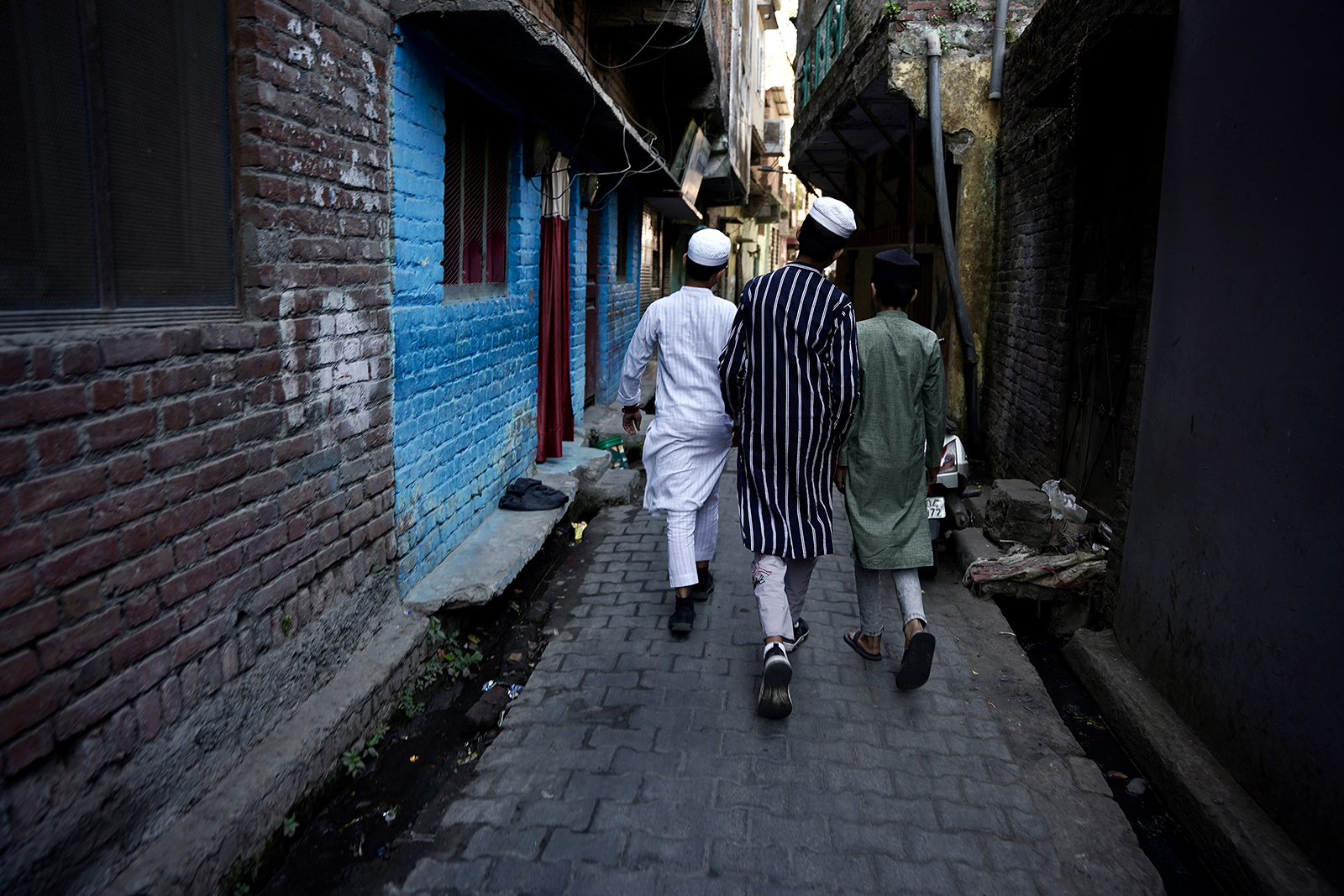
Muslim youth pass through the Banbhoolpura neighborhood of Haldwani, India, Feb. 23, 2024. (Photo by Bhat Burhan)
An uneasy silence has since settled over Banbhoolpura, which houses many of Haldwani’s skilled laborers. While the curfew was lifted on Feb. 20 — 12 days after the violence broke out — the residents haven’t yet restored the neighborhood to order.
The land where the mosque once stood is now designated for the construction of a police station to maintain surveillance on the ghetto.
The violence was a “man-made disaster,” said a senior police official stationed on the site, requesting anonymity, as he was not allowed to speak with the press. “The damage has been done. Unfortunately, people have lost their lives. However, peace has returned, and we are consistently monitoring the situation 24/7 to maintain tranquility.”
